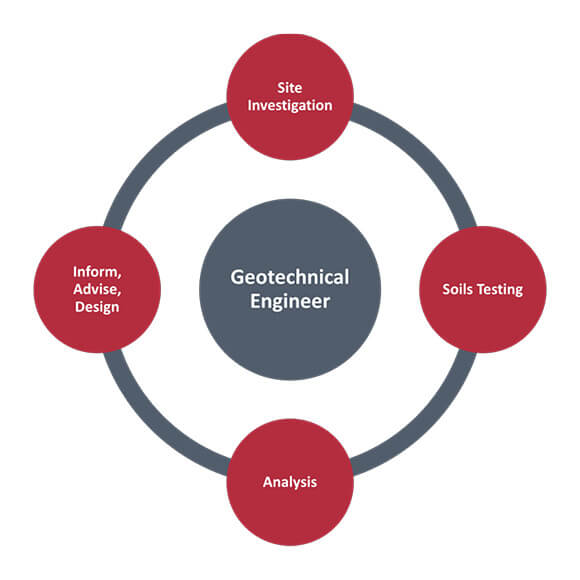Fascination About Geotheta
Fascination About Geotheta
Blog Article
The Ultimate Guide To Geotheta
Table of ContentsThe 2-Minute Rule for GeothetaGeotheta for BeginnersThe 6-Second Trick For GeothetaThe smart Trick of Geotheta That Nobody is Talking AboutGet This Report about Geotheta

They carry out website investigations, collect examples, execute laboratory tests, and analyze data to assess the suitability of the ground for construction jobs - Tailings Engineer. Based upon their findings, geotechnical designers supply referrals for structure layout, slope stability, retaining frameworks, and mitigation of geotechnical hazards. They work together with other experts, such as engineers, architectural designers, and building and construction groups, to make certain that geotechnical factors to consider are incorporated right into the total task layout and implementation
By assessing the behavior and buildings of dirt and rock, they can recognize possible geotechnical dangers such as landslides, dirt negotiation, or incline instability. Their knowledge helps avoid failures or mishaps that can jeopardize lives and residential or commercial property. Here are some detailed duties and duties of a geotechnical designer: Website Investigation: Geotechnical engineers conduct website examinations to collect data on subsurface problems.
They interpret the data to understand the residential properties and actions of the dirt and rock, including their toughness, leaks in the structure, compaction characteristics, and groundwater conditions. Geotechnical Evaluation and Design: Geotechnical designers assess the information accumulated throughout website examinations to examine the stability and viability of the site for building jobs. They perform geotechnical estimations and modeling to examine aspects such as birthing capability, settlement, slope security, side planet stress, and groundwater flow.
The smart Trick of Geotheta That Nobody is Discussing
Structure Style: Geotechnical designers play a crucial duty in creating foundations that can securely support the desired structure. They assess the dirt conditions and lots requirements to determine the proper foundation kind, such as shallow structures (e.g., grounds), deep structures (e.g (https://geotheta.webflow.io/)., heaps), or specialized strategies like dirt enhancement. They think about elements such as settlement restrictions, bearing capacity, and soil-structure communication to create optimal foundation designs
They assess building and construction plans, display site activities, and conduct area assessments to validate that the style recommendations are followed. If unpredicted geotechnical problems occur, they assess the scenario and supply recommendations for removal or modifications to the layout. Danger Assessment and Reduction: Geotechnical engineers analyze geotechnical risks and risks related to the project website, such as landslides, liquefaction, or soil disintegration.

Partnership and Communication: Geotechnical designers work very closely with other professionals associated with a project, such as designers, structural designers, and construction groups. Efficient communication and partnership are vital to integrate geotechnical factors to consider into the overall task style and construction procedure. Geotechnical designers supply blog technical competence, answer inquiries, and ensure that geotechnical demands are met.
Not known Incorrect Statements About Geotheta
Below are some kinds of geotechnical engineers: Foundation Engineer: Structure engineers specialize in making and evaluating structures for frameworks. They analyze the dirt conditions, tons demands, and website features to determine one of the most appropriate foundation type and style, such as shallow structures, deep foundations, or specialized methods like pile foundations.
They assess the elements influencing slope stability, such as soil homes, groundwater conditions, and slope geometry, and develop techniques to stop incline failures and alleviate dangers. Earthquake Designer: Quake designers concentrate on assessing and designing structures to withstand seismic forces. They assess the seismic hazard of a website, review dirt liquefaction capacity, and develop seismic design standards to make certain the safety and security and strength of structures during earthquakes.
They perform area screening, gather samples, and assess the accumulated data to characterize the dirt properties, geologic developments, and groundwater conditions at a site. Geotechnical Instrumentation Engineer: Geotechnical instrumentation designers concentrate on monitoring and gauging the habits of soil, rock, and frameworks. They set up and maintain instrumentation systems that keep an eye on aspects such as soil negotiation, groundwater levels, slope activities, and structural variations to assess performance and provide very early warnings of possible issues.
The 10-Second Trick For Geotheta
They carry out examinations such as triaxial tests, debt consolidation examinations, direct shear tests, and leaks in the structure tests to collect information for geotechnical evaluation and layout. Geosynthetics Engineer: Geosynthetics designers focus on the design and application of geosynthetic materials, such as geotextiles, geogrids, and geomembranes. They use these products to boost soil stability, enhance slopes, supply drainage solutions, and control disintegration.
They tend to be investigatory individuals, which means they're intellectual, introspective, and inquisitive. They are curious, systematic, rational, logical, and sensible. Several of them are also social, implying they're kind, generous, participating, person, caring, handy, compassionate, sensible, and pleasant. Does this sound like you? Take our complimentary job test to learn if geotechnical engineer is among your top occupation matches.
In the workplace setting, geotechnical engineers make use of specialized software application tools to execute computations, produce layouts, and evaluate data. They prepare records, testimonial task specifications, communicate with clients and employee, and coordinate job activities. The office setting offers a favorable atmosphere for study, analysis, and cooperation with other specialists included in the project.
The Of Geotheta
They regularly go to job websites to carry out website examinations, assess geotechnical conditions, and gather information for analysis. These gos to involve traveling to different locations, sometimes in remote or difficult surfaces. Geotechnical designers may carry out soil sampling, conduct examinations, and screen construction activities to make certain that the geotechnical elements of the task are being implemented properly.
Geotechnical engineers also function in specialized geotechnical labs. Geotechnical research laboratory designers work extensively in these atmospheres, managing testing devices, operating instruments, and recording data.
Report this page